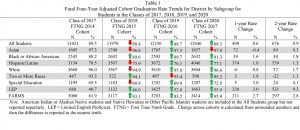Has MCPS gone too far with its grade inflation policies?
Junior Ivan Wang looks over a Spanish test that was curved in order to boost students’ grades.
The 50% rule, 89.5% being an A, and getting rid of the semester downtrend rule have all been recent attempts by Montgomery County Public Schools to implement grade inflation into the school system. These changes are meant to benefit students’ mental health and improve their chances of being accepted into college. However, the addition of these grade inflation policies has resulted in unintentional adverse effects.
College applications are an important part of high school for most students. Grade inflation policies are meant to boost students’ odds of being accepted, but how can colleges differentiate between students if they all have excellent grades in difficult subjects? With newly implemented test optional policies, colleges have an even tougher time deciding who to reject and accept. This can lead to a college acceptance seeming like it happened due to luck, which is not rewarding for students who put in the effort and got a 99% in a class as opposed to an 89.5% (both of these grades look the same on the submitted transcript).
In the 2016-2017 school year, MCPS decided to remove the semester downtrend rule, which meant that, for example, receiving an A first quarter and B second quarter would result in a semester grade of an A. This was not previously the case as a student would need to earn either an A or B in the first marking period and then earn an A in the second marking period to earn an overall semester A. Although this policy has caused an increase in overall average GPA, it has also caused students to be less motivated in the second marking period of a semester if they received an A in the first marking period. Without rewarding students for their hard work, they are less likely to put in maximum effort, which means that the second and fourth quarters result in unnecessary and ineffective learning gaps.
One more groundbreaking addition to the MCPS grading system was the 50% rule. This rule states that if students put in effort into an assignment, they automatically receive a 50% for attempting to do the assignment even if they answer every question incorrectly. Although this rule has minimized the number of students who receive Es as both their marking period and semester grades, it has had more pronounced consequences as well. If a student has guaranteed themselves an A at the end of the quarter, they can put minimal effort into one or two assignments, receive 50% on them, and squeak out with an A for that marking period. This type of grade inflation is not good for the students who would otherwise receive an E as their final grade because it unrealistically prepared them for college and the real world. It is also not beneficial for the students who are only motivated to do well in school by their grades because then they do not have to put in any real effort in the last leg of a quarter.
Although getting rid of all of these rules at once would be a massive change for students, slowly rolling back the number of instances in which they can be applied would be a good start in the right direction towards a fair and rewarding grading system. Over time, students would become acclimated to the uninflated grading system and the rules could be eliminated completely. This would allow for students to feel prideful about their grades and colleges to get a true sense of where students are in their overall knowledge and education.
Your donation will support the student journalists of Thomas S. Wootton High School. Your contribution will allow us to purchase equipment and cover our annual website hosting costs.
Daniel is a 2023 graduate.










